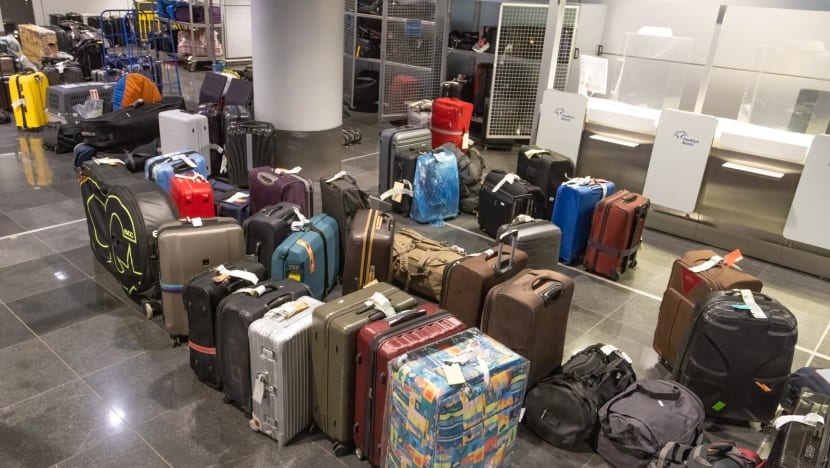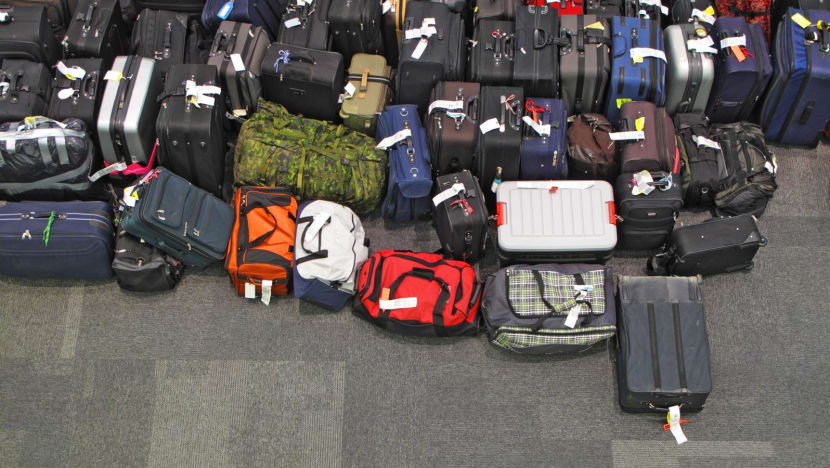CNA Explains: Why do airlines offload luggage when faced with adverse weather conditions?
How does the weather affect an airline's decision to leave luggage behind? Are there other options? Aviation experts explain after a Scoot flight was recently forced to offload baggage.

A stock photo of luggage at an airport. (Photo: iStock)
SINGAPORE: Some passengers travelling on board Scoot flight TR134 from Singapore to Xi'an last week arrived in the Chinese city without their luggage.
The airline said it had to leave some bags behind before departure due to "unusually strong headwinds that impacted the performance of the aircraft".
How does the weather affect the decision to offload luggage? How often does it happen? And are there other ways to manage the situation?
CNA spoke to four aviation experts to find out.
Why do airlines leave luggage behind?
Airlines may leave luggage behind due to poor weather or other operational considerations, to ensure that planes maintain proper weight in such conditions.
"Aircraft must maintain a proper weight and balance for safe operation. Poor weather can affect this balance, and removing luggage can help achieve it," said Associate Professor Sameer Alam, the deputy director of the Air Traffic Management Research Institute at Singapore's Nanyang Technological University.
Weight and balance calculations consider the weight distribution of passengers, luggage and cargo, he added.
"In the case of strong headwinds or other adverse weather conditions, the aircraft may consume more fuel than anticipated due to route deviation or due to (an) increase in thrust to maintain ground speed," he continued.
"To ensure they have enough fuel for the journey, airlines may reduce weight by leaving some luggage behind."
Former Singapore Airlines executive Chow Kok Wah said engines have to burn more fuel to fly the same mile if the plane is flying against strong headwinds.
"To overcome this, the plane will offload cargo ... or offload some passengers or only their baggage. The aim is to save some fuel to fly further or fly harder," he added.
Aviation consultant Alastair Rosenschein echoed some of Assoc Prof Sameer's points, highlighting how conditions on departure can also affect the amount of weight that an aircraft can carry.
Hot air temperature at the departure airport, for instance, may cause a reduction in the maximum take-off weight, he said.
"Sometimes when the weather at the destination airport is poor, extra diversion fuel may have to be carried at the expense of payload (baggage, passengers and cargo)," he noted.
Mr Rosenschein added that high-altitude airports also call for reduced maximum take-off weights.
Other circumstances for luggage removal include aircraft maintenance issues, security concerns or passenger-related issues like late arrivals, said Assoc Prof Sameer.
Does the type of aircraft or the travel route matter?
In the specific case of TR134, the Asia managing editor of aerospace news website FlightGlobal Greg Waldron drew attention to the type of aircraft used for the flight – a narrow-body Airbus A320, according to data on flight tracker Flightradar24.
In travelling between Singapore and Xi'an, an A320 would be reaching the limits of its range.
"Xi'an is quite far north of Singapore, right? So … you'd already be getting to the (limit) of the aircraft range, effective range," he said.
"Airlines, when facing extreme weather conditions like strong headwinds, that kind of thing, they have to be very cautious of the weight of the aircraft … basically you're looking at the weight of the aircraft, and you arrive in Xi'an and you're going to have to have a certain amount of fuel on the aircraft just in case you need to make a diversion and so forth," he added.
Mr Rosenschein also discussed aircraft range limits, saying: "All aircraft have (a) maximum operational range which is determined by take-off WAT (weight, altitude and temperature) limits and inflight headwinds along with operational altitude for the flight which can be determined by the density of air traffic on the day."
Mr Waldron added that a similar situation to what TR134 passengers experienced may not have happened on a flight between Singapore and a closer destination, such as Kuala Lumpur or Phuket.
Like Mr Rosenschein, Mr Waldron said that taking off from hot locations such as Singapore and Dubai is also a bit harder on aircraft compared to take-offs in, for example, northern Europe on a cool day.
In certain situations, airlines may prioritise cargo over luggage if the cargo is time-sensitive or critical, Assoc Prof Sameer said.
"The factors that lead to such decisions include the specific circumstances of the flight, aircraft type, weather conditions and airline policies," he added.

How often does this happen?
Mr Chow said such incidents are rare.
"Only flights that are operating near the limit of its designed range and also happen to have full pax load and bad weather will be in this predicament," he explained.
"If a plane designed to fly six hours is assigned to a four-hour route, it would be extremely rare to end up in such (a) situation."
Mr Waldron said that while such incidents are "not terribly common", there are two factors which could contribute to them occurring more frequently.
One is the rise of low-cost carriers.
"They have very specific weight requirements for baggage, so that could be a part of it," he said.
The other is climate change.
"Now with climate change … you're going to see more extreme weather conditions, stronger winds here and there, storms, this kind of thing, and this could have an impact on the payload that aircraft can carry as well," he said.
Citing research he has seen, Mr Waldron said that turbulence could get more extreme in the future because of climate change.
Returning to the subject of range limits, Mr Rosenschein said that they can also determine how often these incidents happen.
"These incidents are common when an aircraft is operating close to or at maximum range where the WAT limits are critical or en route headwinds are strong," he said.
"When aircraft are operating well within their maximum range and departing an airport with a long runway then these incidents are extremely rare.
"Most modern aircraft have very good performance and range capabilities, but some airlines operate their aircraft on long routes close to their aircraft maximum range and that is when these incidents are most common."
Assoc Prof Sameer said the frequency of such cases varies depending on airline procedures, routes and weather patterns.
Are there other solutions?
Instead of offloading luggage, one option is for planes to carry extra fuel - but this has its limitations.
"Regarding fuel supply, airlines calculate fuel loads based on various factors, including the expected weather conditions," Assoc Prof Sameer said.
"Carrying extra fuel for every flight would increase operational costs and reduce efficiency."
Mr Waldron expressed a similar view.
"You can carry more fuel, but of course, the issue with carrying (more) fuel is there is certainly a limit to the amount of fuel that the aircraft can carry," he said.
"The other issue with carrying fuel is that you're burning, early in the flight, you're burning lots of fuel just to carry that extra fuel to the destination.
"Fuel actually weighs a lot as well, so getting it off the ground and into the air, it's a big expenditure, and at the extreme ranges of commercial aircraft – or any aircraft really – the performance of the aircraft really starts to fall off. So the benefit you get from carrying that extra fuel starts to fall off quite sharply as you get very deep into a long flight."
Fuel is also one of the biggest costs, if not the single biggest cost for airlines, Mr Waldron said, so adding more fuel could be a cost issue for carriers.
Mr Rosenschein, too, spoke of the limit to how much fuel an aircraft can carry and highlighted some alternatives to offloading baggage.
"The maximum amount of fuel that can be loaded is determined by the size of the fuel tanks and the air temperature of the departure airport – warm fuel expands therefore reducing the weight of fuel that can be loaded," he said.
"Offloading baggage or cargo may be the only two operational possibilities on some flights.
"Landing en route to refuel is another option but (this) takes time and is costly."
Other options include reducing the number of passengers and taking off later in the day when the departure airport is cooler, or when there might be a higher take-off headwind forecast.
Mr Waldron said that some airlines, particularly when travelling to destinations that are further away, will reduce weight by leaving a few seats at the back of their planes empty.
Are passengers compensated?
Passengers are typically compensated for the inconvenience of having their luggage stuck at their point of departure.
"Passengers are usually compensated for delayed luggage according to the airline's policies, which may include providing essentials like toiletries or clothing and reimbursement for expenses incurred due to the delay," said Assoc Prof Sameer.














.jpg?itok=70_Hy73Q)





